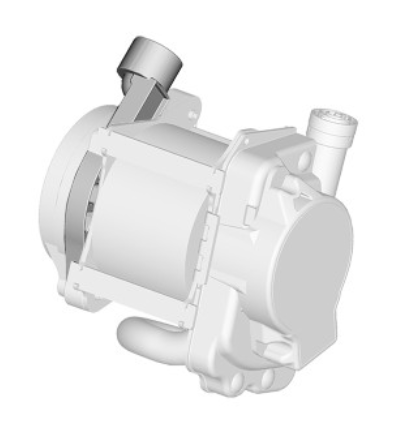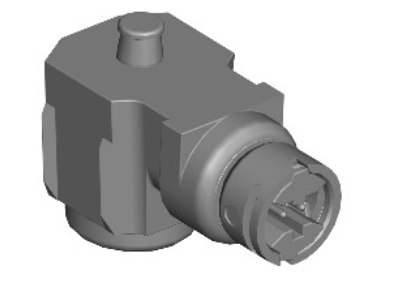Land Rover Discovery: Load Limiter Actuator (Nas Passenger Seatbelt Only)

On North American Specification (NAS) vehicles, a pyrotechnic load limiter actuator is incorporated into the retractor of the passenger seatbelt to provide an adaptive load limiter. The adaptive load limiter has two different load limits, the standard load limit and a lower load limit. The lower load limit is designed to reduce the chest loading for smaller seat occupants during an impact, and is engaged when the Restraints Control Module (RCM) fires the load limiter actuator.
STEERING COLUMN COLLAPSE ACTUATOR (NAS MARKET)

A steering column collapse actuator is installed to provide increased energy absorption, if a crash situation occurs.
For additional information, refer to: Steering Column (211-04 Steering Column, Description and Operation)..
OPERATION
In a collision, the force of the impact is measured by the impact sensors, impact pressure sensors and the Restraints Control Module (RCM). The RCM evaluates the readings to determine the impact point on the vehicle and whether the readings exceed the limits for firing any of the airbags and pretensioners. During a collision, the RCM only fires the airbags, air curtains and pretensioners if the safing function confirms that the data from the impact sensor(s) indicates an impact limit has been exceeded.
The RCM incorporates the following impact thresholds to cater for different accident scenarios:
- Front impact, pretensioners.
- Front impact, driver and passenger airbags stage 1, belt unfastened.
- Front impact, driver and passenger airbags stage 1, belt unfastened.
- Front impact, driver and passenger airbags stage 2, belt unfastened.
- Front impact, driver and passenger airbags stage 2, belt fastened.
- Rear impact.
- Driver side impact.
- Passenger side impact.
FIRING STRATEGIES
The seatbelt pretensioners are fired when the pretensioner impact limit is exceeded. The RCM only fires the pretensioners if the related seatbelt is fastened.
The driver and passenger airbags are only fired in a frontal impact.
On North American Specification (NAS) vehicles, the passenger airbag is disabled unless the front passenger seat is occupied by a large person. In all markets except NAS, Australia and Japan, the passenger airbag can be selected off in the vehicle Set-up menu of the Instrument Cluster (IC).
If there is a fault with a seatbelt buckle switch, the RCM assumes the related seatbelt is fastened for the pretensioner firing strategy and unfastened for the driver and passenger airbag firing strategies. If there is a fault with the occupant classification sensor, the RCM disables the passenger airbag. If there is a fault with the passenger airbag deactivation switch, the RCM disables the passenger airbag.
If a side impact limit is exceeded, the RCM fires the side airbag and the side head airbag on that side of the vehicle. If the side impact limit on the front passenger side of the vehicle is exceeded, the RCM also evaluates the input from the occupant classification sensor, and fires the side airbag only if the front passenger seat is occupied by a large person (NAS only).
If multiple impacts occur during a crash event, after responding to the primary impact the RCM will output the appropriate fire signals in response to any further impacts if unfired units are available.
Front and Rear Impact Firing Strategy (All Except NAS)
.19.jpg)
Front and Rear Impact Firing Strategy (NAS)
.20.jpg)
.21.jpg)
CRASH SIGNAL
When the Restraints Control Module (RCM) outputs any of the fire signals it also outputs a crash signal to the Central Junction Box (CJB) and the Engine Control Module (ECM) on the High Speed (HS) Controller Area Network (CAN) powertrain bus systems. The crash signal is also hardwired to the ECM and the CJB. On receipt of the crash signal, the ECM cuts the power supply to the fuel pump relay and the CJB goes into crash mode. In the crash mode, the CJB:
- Activates all of the unlock signals of the vehicle locking system, even if the vehicle is already unlocked.
- Ignores all locking/superlocking inputs until it receives an unlock input, when it returns the locking system to normal operation.
- Activates the interior lamps. The interior lamps remain on permanently until they are manually switched off at the lamp unit, or the CJB crash mode is switched off and they return to normal operation.
- Disables the rear window child lock input until the crash mode is switched off.
- Activates the hazard flashers. The hazard flashers remain on until cancelled by the hazard warning switch or the crash mode is switched off.
The CJB crash mode is switched off by a valid locking and unlocking cycle of the locking system.
CONTROL DIAGRAM
.22.jpg)
- Restraints Control Module (RCM)
- Occupant Classification Sensor Control Module (OCSCM)
- Engine Control Module (ECM)
- Passenger airbag deactivation indicator
- Driver lower airbag
- Steering column collapse actuator
- Side air curtains
- Side airbags
- Passenger airbag
- Driver airbag
- Clockspring (CLKSPG)
- Pretensioners
- Ground
- Power supply
- Seatbelt tension sensor
- Impact pressure sensor
- Side impact sensors
- Pedestrian Protection System Control Module (PPSCM)
- Seatbelt buckle
- Driver seat position sensor
- Occupant detection sensor
- Central Junction Box (CJB)
- Battery Junction Box (BJB)
- Battery
Supplemental restraint system specifications
.23.jpg)

